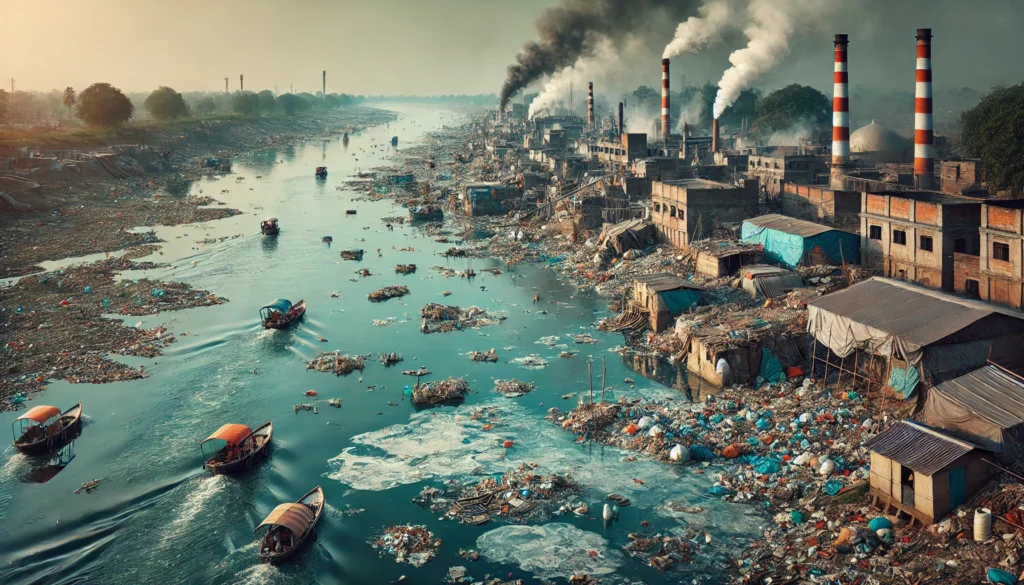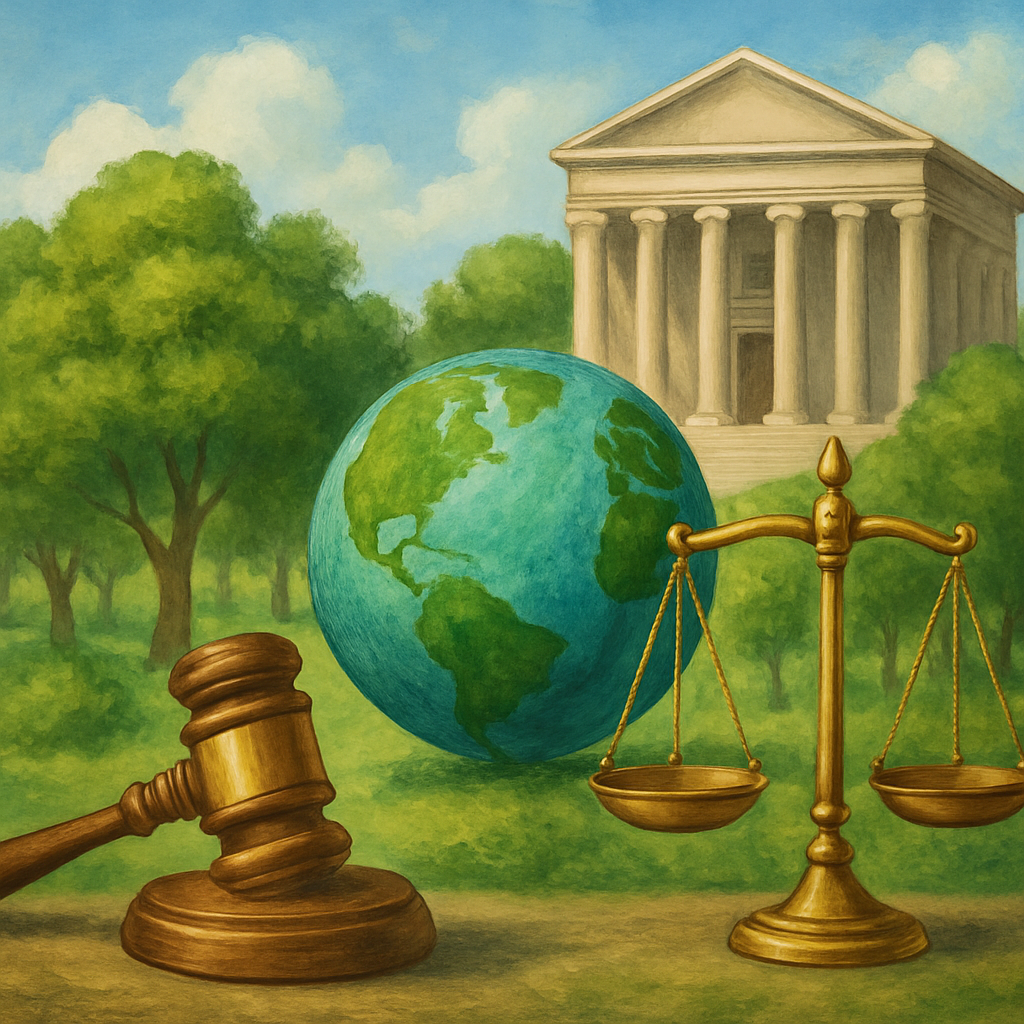Published on 8th April 2025
Authored By: Parin Maurya
Gujarat University
“We are the first generation to feel the effect of climate change and the last generation who can do something about it.”
Barack Obama, Former US President
Introduction
A Stem professional engineer named Callender began collecting information from over 140 weather station situated across the globe. During his analysis, he realised a surge of 0.3°C in the earth’s temperature in past 5 decades. His arguments blamed carbon dioxide (CO2) that is being ejected from industry a major reason for global warming. However, his study were mostly not regarded by scientists who were of the opinion that humans cannot impact a large system like climate. Astoundingly, his judgements on global warming were lately proven accurate and in consonance with modern evaluations.[1] The global warming (that is caused by greenhouse gases) is one of the major contributors of climate change, it severely affects the natural habitat, biodiversity, human health and sustainable future goals. Tensed by the said reason, international communities took initiative to keep the earth’s temperature below 2°C and take possible measure to limit it to further 1.5°C.[2]
The Global climate change caused by increased human activity of secreting such gases that further raise the temperature is already causing fatal changes like drought, wildfires, unnatural rainfalls and season changes. According to the Intergovernmental Panel on Climate Change (IPCC) the modern human has never witnessed such changes in climate and some grave changes are irreversible over the next few centuries.[3] Daily tiny changes in the average temperature can turn into large and serious shifts in the climate and weather. To save tomorrow, internationally various countries have joined hands by establishing and enacting various key organisations, covenants and agreements that elaborates on actions that signatory states will combinedly take to fight climate change. The international law has helped signatories in implementing the agreed rules and regulations into their municipal laws to express the seriousness of the issue and to ensure its effective implementation.
This article is an attempt to elaborate on what & why aspect of climate change along with what communities in power are doing nationally and internationally to address it. The first section will discuss about the why and what aspects of climate change, following the second section that will explain international conventions and agreements. The third section will discuss how India as a developing country is adhering to the laws relating to climate change, the end part i.e. fourth section will conclude the thesis.
Change in Climate
Climate is considered as the extended period of weather pattern experienced in a place. On the other hand, weather portrays daily changes in the atmosphere. The former affects almost every area of human life from the food source to what we wear, how we travel, where we go on holiday etc., it has a great impact on our health and future. Climate assessments display how much winter, summer, rain to expect this season or how sea levels will remain during the period, along with what part of the world is likely to expect major weather problems or which species will get affected or possibly endangered by climate change.[4] Studies reveal not just increase in temperature but rise in global sea levels, reduction in glaciers, frequent changes in regional weather patterns as well as ocean and atmospheric circulations that encourages seasonal rainfall conditions.
The additional heat resulting from greenhouse gas emissions is a contributing factor in such irregular changes. Such gases are an outcome of human activities to name a few, extracting fossil fuels, rigid and high volume construction that disturbs the land, deforestation for various purposes, running gigantic industry that releases harmful chemicals in the environment and even agriculture is one of the partners in such excretions. Said activities accelerates “heat trapping” that absorbs and retain heat from sun, preventing it from escaping back into space and thus warming the planet. The patterns of changes in the climate system matches the effects expected from an increased greenhouse effect. Other natural influencers of climate change such as volcanoes, the sun and natural variability cannot fully account for the extent and timing of the warming we see today. This suggests that human activities are responsible for atmospheric amendments, it can be directly through harmful particles and gases or indirectly through natural atmospheric reactions.[5]
International Legal Frameworks
Apparently, Climate change is one of the greatest tensions in discussions. For almost a century, international law has acted as a tool to fight climate change, it obliges various states to abide by the minimum standards set for climate protection. The law acts in the interests of the nature and respects the sovereign right of the state. Such law internationally enacts laws and policy that signatories are bound wither morally or legally to implement in their municipal law, promising effective enforcement for the betterment of the generations and safeguarding the nature.[6] We will discuss some of the major international law that aims to safeguard the climate as a whole.
United Nations Framework Convention on Climate Change (UNFCCC):-
It is a multilateral treaty that was inaugurated in the year 1992 and has been actively providing a platform open for discussion and negotiations on climate change. It has given birth to various key agreements namely, Paris Agreement (2015), Kyoto Protocol (1997). The preamble of the convention is “stabilisation of greenhouse gas concentrations in the atmosphere at a level that would prevent dangerous anthropogenic interference with the climate system”. The parties agree to realise the existence of triggers of climate change and take possible efforts to combat it. The convention practices a mechanism that allows party to work together to accomplish this gaol. The Conference of the Parties (COP) is the apex authority that maintains checks and balances at a regular basis on climate policy. The secretariat works in coordination with the COP by preparing information and necessary documentation, providing required assistance to developing countries. Moreover, Subsidiaries body provides scientific and technological advice while simultaneously evaluating the implementation.[7]
The principle of Common but Differentiated Responsibility (CBDR) and Respective Capability sets this convention apart as it does not have its own targets because it helps in identifying frameworks for future agreements and policies. This principle says that capabilities varies from state to state and to fight climate change they want to use a balanced framework that suits the need for all states to fight climate change with different levels of responsibility for greenhouse gas emissions. In total 198 countries have acquired membership that are inclined towards protecting climate and intimate the organisation on their actions and progress. Talking about the latest COP29 that proves how this convention is acting, The UN climate conference was held in Baku, Azerbaijan on 24 November 2024. The conference entered into an agreement calling on developed countries to spend at least $300 billion every year to developing countries by 2035 to reduce greenhouse gas emissions, protect lives and livelihoods from the deteriorating effects of climate change.[8]
Kyoto Protocol (1997):-
The Kyoto protocol is named after the Third COP held at Kyoto, Japan in the year 1997 where 160 nations joined to agree on the initiative of climate change. One of the first protocol that inculcated legally binding targets and commitments, where key economic players like Japan, UK the European Union accepted to curb their emissions by 7%, 8% and 9% with due respect.[9] As the Convention itself only encourages these countries to create mitigation policies and report on their progress, this Protocol enforces it by setting deadlines to their goal. Just like the Convention, the Kyoto protocol also puts pressure on the developed countries through the principle of “Common but Difference Responsibilities and Respective Capabilities”. It is a step to duty bound the wealthier nations to contribute the most in the era of high levels of GHG emissions. Annexure B of the Protocol provides legally binding targets to reduce emissions for 37 industrialised nations, economies in transition, and the European Union. Collectively, these commitments aimed to cut emissions by an average of 5% below 1990 levels during the first commitment period from 2008 to 2012.
The Doha Amendment adopted on 8 December 2012 in Qatar extending the Kyoto Protocol into a second commitment period (2013-2020) officially came into force in December 2020, enacted following key updates which were ratified by 147 parties.
- New commitments for Annex I countries to reduce emissions during the second period.
- Expanded list of greenhouse gases (GHGs) to be monitored.
- Revisions to the Protocol’s articles to reflect the new timeframe.
Elaborating on its Greenhouse Gas Emission reduction target in the First commitment period (2008–2012) 37 industrialized nations and the EU pledged a 5% reduction below 1990 levels. Whereas, in Second commitment period (2013–2020) the participating countries aimed for at least an 18% reduction below 1990 levels. However, the group of committed countries changed compared to the first period. To help countries meet their targets, the Protocol introduced flexible market mechanisms based on emissions trading, where countries can buy and sell emissions permits via International Emissions Trading, introduction of Clean Development Mechanism (CDM) which allows investment in emission-reducing projects in developing countries and an initiative of Joint Implementation (JI) that enables developed countries to invest in emission reduction projects in other industrialized nations. These mechanisms encourage cost-effective emission reductions, attract green investment in developing nations, and support the adoption of cleaner technologies. The Protocol established a strict monitoring and compliance system to ensure transparency by binding countries to keep a track and report emissions through annual inventories and national reports, an international transaction log, maintained by the UN Climate Change Secretariat that verifies all trades and transactions.[10]
Paris Agreement (2015):-
Paris agreement is an outcome of the United Nations Climate Change Conference (COP21) in Paris to fight climate change as it is an issue that requires attention and cooperation of every state on earth. It is a legally binding treaty which was adopted by 196 parties in the year 2015 with a goal to hold “the increase in the global average temperature to well below 2°C above pre-industrial levels” and take efforts “to limit the temperature increase to 1.5°C above pre-industrial levels.” To keep global warming below 1.5°C, greenhouse gas emissions must reach their peak no later than 2025 and then drop by 43% by 2030. This requires urgent and significant reductions in emissions across all sectors, along with a rapid transition to clean energy and sustainable practices. Paris agreement is recognised in the multilateral climate change process due to its binding nature which break the history of sanction less treaties.
The Paris Agreement requires countries to submit Nationally Determined Contributions (NDCs), specifying their plans to reduce emissions, following a 5 year plan. However, rather than enforcing strict penalties, the Agreement’s compliance mechanism is designed to support and encourage progress. To elaborate, article 6 establishes global carbon markets to help countries meet their climate goals efficiently. Whereas article 8 focuses on compensating developing nations for climate related loss and damage. Climate change also intersects with human rights and migration law, as it disproportionately affects vulnerable communities.[11] Acknowledging the urgency of limiting the temperature well below 1.5°C, COP27 was called on countries to review and strengthen their 2030 targets by the end of 2023, while discussing about their national circumstances. Along with the short term NDCs, countries are also encouraged to submit Long-Term Low Emissions Development Strategies (LT-LEDS), such plans offer a long term vision for sustainable growth, though they are not mandatory like NDCs. Instead, they help align climate action with broader national development goals.
This agreement advises developed countries to support developing or underdeveloped countries by financial assistance, technology transfer, building capacity. This agreement has made many countries, cities and business set carbon neutrality targets and it is also said that zero carbon technologies are now competitive creating new business opportunities as it represents 25% of emissions. This trend has created more business opportunities for beginners in the transport and power sector. It is expected that by 2030, these solutions could be cost-effective in industries responsible for over 70% of global emissions, paving the way for a sustainable future.[12]
Montreal Protocol: Protecting the ozone layer:-
The Montreal Protocol is a global agreement designed to protect the Earth’s ozone layer by phasing out Ozone Depleting Substances (ODS) in both production and consumption, was signed in 1987. The signatories to the protocol meet once every year to discuss their action and further decide on the know-how to successfully implement the protocol. This discussion brings amendments to ensure periodic adjustment for latest problems to ensure the goal of the protocol is not compromised. The recent amendments called Kigali Amendment that took effect in 2016 talks about the elimination of hydrofluorocarbons(a chemical that was initially used as ODC that was later found a harmful gas) to avoid damage to the ozone layer as they are one of the harmful greenhouse gases that contributes in climate change. This protocol has been highly effective, offering clear, actionable steps that countries worldwide have successfully followed. As a result, the ozone layer is on track to recover, demonstrating the power of international cooperation in tackling environmental challenges.
Glasgow Climate Pact (COP26 Outcomes) :-
From 1st to 12th November 2021, Glasgow hosted COP26, the 26th United Nations Climate Change Conference. This annual summit brought together world leaders, scientists, and policymakers to accelerate global climate action and strengthen commitments under the Paris Agreement. At COP26, global leaders acknowledged the urgent need for stronger climate action. Ministers agreed that countries should submit more ambitious 2030 emissions reduction targets in the next year to help keep global warming within 1.5°C. Additionally, they called on developed nations to provide more financial support to help vulnerable countries adapt to climate impacts, such as declining crop yields and extreme weather events. In addition to that, countries pledged to cut methane emissions which is also a potent greenhouse gas and their commitments extended to halt and reverse deforestation. Moreover, the financial sector aimed to align investments with net-zero goals by 2050. The agreements also discussed about reducing coal use, moving away from internal combustion engines, and ending international fossil fuel financing.
National Legal Perspective
India, a developing country and a serious victim of climate change has implemented a comprehensive strategy to combat climate change, encompassing national policies, legislative measures, and international commitments.
National Action Plan on Climate Change (NAPCC):-
The action plan is the primary framework for tackling climate change while promoting sustainable development that came into force in 2008. It consists of eight national missions each addresses specific issues relating to climate change:
- National Solar Mission: That promotes solar energy development, international collaboration on technology development, and domestic manufacturing to make solar power competitive with fossil fuels.
- National Mission for Enhanced Energy Efficiency: That encourages energy efficiency in industries through mandates and by allowing the trade of energy-saving certificates and financial incentives.
- National Mission on Sustainable Habitat: That focuses on energy-efficient urban planning, enforcement of better fuel economy standards, waste management, and promoting public transport.
- National Water Mission: That aims to improve water-use efficiency by 20%, addressing water scarcity.
- National Mission for Sustaining the Himalayan Ecosystem: That seeks to protect Himalayan glaciers and biodiversity from climate change impacts.
- Green India Mission: That plans to afforest 6 million hectares of degraded land and expand forest cover from 23% to 33%.
- National Mission for Sustainable Agriculture: That supports climate resilient farming, weather insurance, and sustainable agricultural practices.
- National Mission on Strategic Knowledge for Climate Change: That enhances climate research, international cooperation, and technology development.
Other Climate Initiatives:
- To produce power by phasing out inefficient coal plants and promoting cleaner technologies via research and development.
- To further promote renewable energy sources by mandating power utilities to source a portion of electricity from non fossil fuel sources.
- To implement religiously energy efficiency laws that requires energy audits in industries and implements energy labelling for appliances.
- To strengthen healthcare services to address climate related diseases.
Ministries that are primarily accountable for each mission are instructed to create objectives, strategies for implementation, timelines, and criteria for monitoring and evaluation to be presented to the Prime Minister’s Council on Climate Change. The Council will also take charge of regularly reviewing and reporting on the progress of each mission. To measure progress effectively, suitable indicators and methodologies will be established to evaluate both emissions avoided and benefits of adaptation. Similar to the National Action Plan, India also has a State Action Plan for climate change which outlines agreed state government’s strategy to address climate change, including specific actions to reduce greenhouse gas emissions and promote sustainable practices across various sectors like energy, transportation, agriculture, and land use with defined targets and implementation timelines.
Long-Term Low Emission Development Strategy to UNFCCC
India took an initiative by enacting Long-Term Low Emission Development Strategy (LT-LEDS) at COP27, displaying a balanced approach to climate action while prioritising economic growth and energy security. This strategy aligns with the Paris Agreement and India’s commitment to climate justice and sustainable lifestyles. The initiative focuses on:
- Energy Transition & Security by gradual, inclusive shift from fossil fuels while ensuring energy security and expand green hydrogen production under the National Hydrogen Mission. It also aims for a threefold increase in nuclear power capacity by 2032.
- Sustainable Transportation by wider adoption of electric vehicles (EVs) and biofuels (20% ethanol blending by 2025) and shifting the citizens towards public transport for both passengers and freight.
- Urban Development & Infrastructure by smart city initiatives that integrate climate resilience and resource efficiency with effective green building codes and better waste management strategies.
- Industrial Growth with Low Carbon Development by energy efficiency initiatives like the Perform, Achieve and Trade (PAT) scheme. Increase in electrification and recycling to strengthen the circular economy by also providing possible solutions for hard-to-abate industries like steel, cement, and aluminum.
- Forest & Carbon Sequestration where India has consistently increased forest cover, making forests a net carbon sink and is on track to meet the 2030 target of 2.5–3 billion tonnes of additional CO₂ sequestration.
- Climate Finance & Global Cooperation because this transition requires trillions of dollars by 2050 it calls for enhanced climate finance from developed nations through grants and concessional loans.
India’s LT-LEDS aligns with “LiFE – Lifestyle for the Environment,” promoting a shift from reckless consumption to responsible resource use. It ensures that India’s economic transformation is environmentally sustainable while demanding fairness in global climate action.
Air (Prevention and Control of Pollution) Act, 1981
The Act aims to prevent, control, and abate air pollution in India by establishing boards with the necessary powers and functions to regulate activities that contribute to air pollution, essentially setting a legal framework to manage air quality in the country. The boards established under this Act holds the power to issue directions to industries, conduct inspections, and impose penalties for violations.
Environment Protection Act, 1986
The main objective of this statute is to safeguard and improve the environment by providing a legal framework that protect, conserve, and enhance environmental resources, primarily focusing on preventing and controlling environmental pollution across all forms like air, water, soil, and noise, while also addressing issues related to environmental degradation. Mainly, the Act works to protect human health and the ecosystem by regulating pollutants secretion and hazardous materials.
Energy Conservation Amendment Act 2022
This amendment in the Act was introduced to further enhance energy efficiency measures and promote the use of renewable energy sources within the country, particularly focusing on building rigid energy codes and regulations for energy consumption across various sectors. This change is implemented as a step towards India’s commitment to reducing greenhouse gas emissions and achieving its renewable energy targets. This amendment is designed to support India’s promises made at COP-26, ensuring a cleaner and more sustainable future. India has set ambitious climate goals, including:
- Expanding non-fossil energy capacity to 500GW by 2030.
- Sourcing 50% of its energy needs from renewables by 2030.
- Cutting one billion tonnes of carbon emissions between COP-26 and 2030.
- Reducing the carbon intensity of its economy by 45% (compared to 2005 levels) by 2030.
- Achieving net-zero emissions by 2070.
These commitments reflect India’s dedication to reducing its carbon footprint while balancing energy security and economic growth.
Electricity Amendment Act, 2023
In order to modernize India’s power sector by promoting renewable energy, and ensuring reliable electricity that is within the interest of nature and every organism on earth. The Act allows deployment of multiple power suppliers in a single area to give consumers more choices and improve service quality. The amendment also strengthens clean energy by mandating a higher share of renewables in the electricity mix, contributing to India’s climate goals. Additionally, it enhances grid reliability, prevents disruptions, and provides regulators more authority to enforce electricity laws and protect consumer interests. By addressing financial challenges faced by power distribution companies, the amendment seeks to create a more sustainable and efficient energy sector, aligning with India’s long-term energy security and economic growth objectives.
Conclusion
The climate change is one of most serious concerns of this era and there is a dire need for strict implementation of what already has been agreed and recognised at national and international level. International agreements provide a collective roadmap for global climate action while national laws and policies ensure localized implementation tailored to each country’s unique circumstances. India, like many other nations, should primarily focus on rigid implementation of existing law with constant promotion of research and development to make sure the country inclusively searches for solutions to fight climate change. In addition, to that considering the population of India, a positive aspect of that if we become successful in sowing a seed of respect in humans towards climate then this people will automatically start to find different ways to conserve the nature. But, due to low literacy rates and lack of relevant exposure the country is helpless it has more important issues to look after. Meaning thereby, even small steps like planting and harbouring trees regularly, not using air conditioner, opting for bicycles and walks for small distance travelling, turning off the engine at signals etc. will count and imagine 143 crore individuals are now implementing such small habits every day, consequently greenhouse gas emissions will decrease gradually. In addition, climate change can be further accelerated by banning partially banning gas stoves and vehicles with fuels from nonrenewable sources. As cooking and traveling is something what a human can’t live without, controlling them would significantly affect climate change positively. Obviously, industry’s other major contributors should be regulated strictly to indirectly force them to find a resort which safeguard climate.
References
[1] A brief history of climate change discoveries, UK Research and Innovation, (Feb., 19, 2025, 10:00 A.M.)
https://www.discover.ukri.org/a-brief-history-of-climate-change-discoveries/index.html
[2] Causes of Climate change, European Commission (Feb., 19, 2025, 12:00 A.M.)
https://climate.ec.europa.eu/climate-change/causes-climate-change_en
[3] The Effects of Climate Change, NASA Science (Feb., 19, 2025, 10:00 A.M.) https://science.nasa.gov/climate-change/effects/
[4] Why is climate important?, National Centre Of Atmospheric Science (Feb., 20, 2025, 10:00 A.M) https://ncas.ac.uk/learn/why-is-climate-important/
[5] Climate Change Overview, Climate Change Knowledge Portal (Feb., 20, 2025, 10:00 A.M) https://climateknowledgeportal.worldbank.org/overview
[6] The International Law on Climate Change – Benoit Mayer – Google Books
[7] What is the UN Framework Convention on Climate Change (UNFCCC)? – Grantham Research Institute on climate change and the environment
[8] What is the UN Framework Convention on Climate Change (UNFCCC)? – Grantham Research Institute on climate change and the environment
[9] Success or failure? The Kyoto Protocol’s troubled legacy – Foresight
[10] What is the Kyoto Protocol? | UNFCCC
[11] Public International Law and Climate Change – Centre for Climate Engagement




